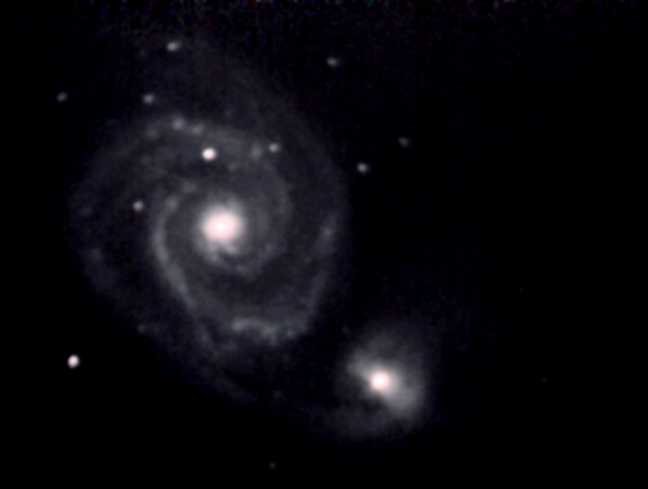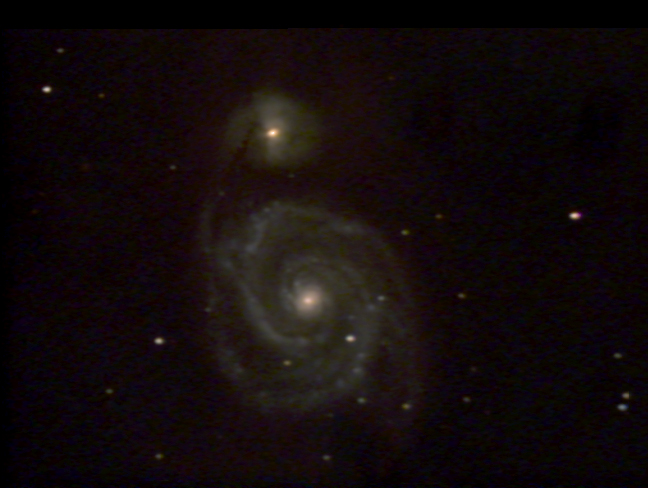
M51: Whirlpool Galaxy
1st Attempt (2nd attempt below):-

RA: 13hr 29min 54sec Dec: 47º 12' 00" Mag: 8.4 Distance: 14 million Light Years Constellation: Canes venatici
This early attempt at one of the most popularly photographed galaxies in our local group should be seen as that. It was taken before I had an equatorial mount, so the individual shots taken and stacked by Envisage were only 15 seconds long each. It was also processed before I had come across Jerry Lodriguss' excellent e-manual 'Photoshop for Astrophotographers' and learnt a little bit about the principles and methodology of processing the raw digital images of astronomical subjects. I should say at this juncture that this manual was invaluable to me in learning the basics although I haven't been able yet to master some of his more complicated techniques - more to do with my inadequacy than the quality of his instruction. I recommend it HIGHLY to any one who is learning to process digital astrophotographs.
The photo that you see was taken on the 28th of May 2005 and consists of 2 images, 2x15 seconds and 25x15, with a total exposure time of just under 7 minutes. I now realise that to get really good images of the Whirlpool galaxy, you need more than an hour's exposure time (preferably several,) to bring out the crystalline stars and milky nebulosity of the arms contrasted against the dust trail of the elongation between the two galaxies, which can be seen in professional and good amateur photographs. Anyway, the 2 images were stacked with MaximDL and the Midtones were increased using the Luminosity channel in Paint Ship Pro 7, after the histogram was stretched to increase the contrast and darken the sky background. Note the slight circumferential elongation of the outlying stars as a result of field rotation. No masking of the galaxy cores was carried out because I didn't know how, and they are therefore overexposed. The raw images had a strong red cast which was corrected for by increasing the blue channel using the Colour Balance command with the Midtone radial button selected, again in Paint Shop Pro 7.
Problems: grossly inadequate exposure time - needed to be a minimum of 10x longer!
2nd Attempt:

The two most obvious differences in this second attempt at M51 is that it is smaller because the photo was taken at f3.3, and it is the right way round as it appears in the sky because the telescope was in polar alignment and not inverted because the star diagonal was not used as in the previous picture. I would have expected much higher quality in this picture but the circumstances of the evening of the 30th of June 2006 when this exposure was made were less than optimal. Seeing quality was extremely poor with a mist in the air, low dew-point, and passing high cloud. The temperature was 18.8°C and the moon was late in the first quarter. This picture is the result of a 35.5 minute exposure total, after stacking 3 separate pictures as follows (14x30 minutes, 42x30, 15x30). Stacking was done with Maxim DL and processing with Photoshop consists of midtone enhancement behind 2 layer masks - one for the stars and galaxy nuclei in negative in order to prevent 'blooming' and the other in positive to block the simultaneous enhancement of the noisy background. Success was limited in this endeavour as the viewer can judge for themselves. Depending on the brightness setting of your monitor, you can see the dirty red/orange powdery glow surrounding the two galaxies.
HOME PICTURES: Deep Sky PICTURES: Solar system PICTURES: Wide field